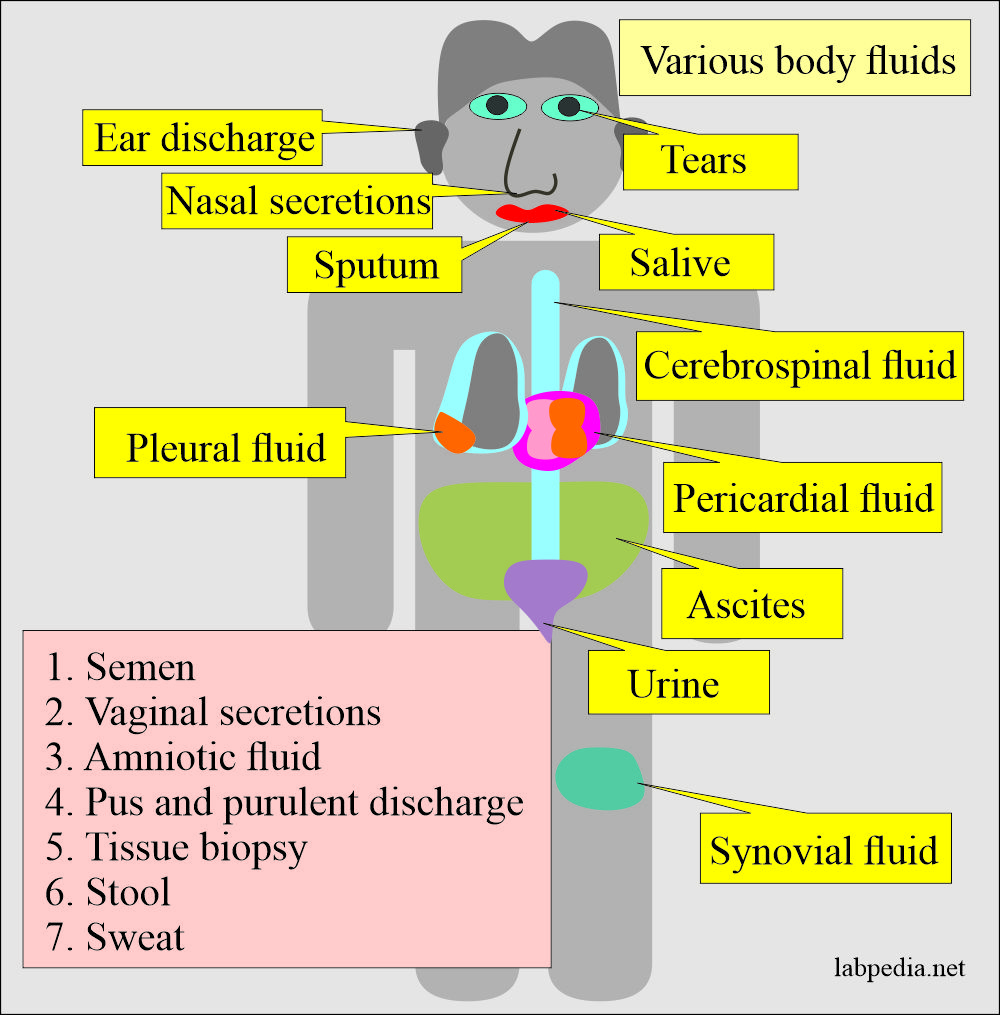Body fluids, Their Importance, and Risk of Infections
Body fluids
Distribution of total body fluids
- The sum of fluids within all body compartments comprises total body water is about 60% of the body weight.
- It is 60% in males and 50% in females, while in infants is 70% of the total body weight.
The body fluids are distributed in various compartments of the body:
- Intracellular fluid:
- It is 40% of the total body weight, around 28 liters.
- Extracellular fluid:
- It is 20% of the total body weight, around 14 liters.
- This fluid may be interstitial = 15% of total body weight (11 liters).
- This may be intravascular = 5% of total body weight (3 liters).
- Total body water = 60% of the total body weight (42 liters).
- It is 20% of the total body weight, around 14 liters.
- At birth, total body water is 75% to 80% of the body weight. It decreases to about 67% during the first year of the baby.
- In adolescence, total body water is around 60% to 65% of total body weight.
- Males have more total body water due to increased muscle mass, and females have less due to body fats.
Water movement between intracellular fluid (ICF) and Extracellular fluid (ECF):
- Potassium (K+) maintains the intracellular fluid (ICF) osmotic balance.
- Sodium (Na+) maintains the extracellular fluid (ECF) osmotic balance.
The distribution of body fluids:
- Blood.
- Bloody fluids.
- Pleural fluid.
- Pericardial fluid.
- Peritoneal fluid (ascites).
- Amniotic fluid.
- Cerebrospinal fluid.
- Semen.
- Urine.
- Vaginal secretions.
- Saliva is a dental procedure.
- Synovial fluid.
- Pus and purulent discharge.
- Tissue biopsy or organ which is unfixed.
Risk and Route of infections:
- Many body fluids, including blood, are infectious and hazardous materials for human beings, particularly people working in the laboratory.
- These biological hazards expose unprotected laboratory workers to bacteria, viruses, parasites, and other biological agents.
- This infection may be from ingestion, inhalation, inoculation, or tactile contact. The infectious material may be inhaled from the patient or their body fluids/tissues.
The source of contamination may be from:
- Contaminated laboratory equipment.
- Improperly processed blood products.
- Inappropriate disposal of laboratory waste products.
Noninfectious material is:
- Sputum.
- Saliva.
- Nasal secretion.
- Sweat.
- Stool.
- Tears.
- Urine.
Importance of various body fluids:
Saliva:
- Salivary glands produce almost one liter of fluid /day, serous and mucinous material.
- Some drugs that can be monitored include Digoxin, Phenytoin, Theophylline, Phenobarbitol, dexamethasone, benzodiazepine, cocaine, heroin, codeine, and nicotine.
- Drug abuse like alcohol, barbiturates, amphetamines, and marijuana can also be monitored.
- The hormones like progesterone, 17-alpha-hydroxyprogesterone, cortisol, DHEA, Androstenedione, and testosterone can also be measured.
- Sjogren’s syndrome can be diagnosed by measuring increased Na+ and chloride.
- Radioactive material is measured for the diagnosis of Hyperthyroidism and hypothyroidism.
- Can diagnose cystic fibrosis.
- Can estimate secretory IgA.
- Take care of saliva contamination by blood due to chewing or flossing.
Nasal secretions:
- It helps to diagnose allergies by showing an increased number of eosinophils.
- An increased number of polys indicates acute infection.
- Increased eosinophils and neutrophils indicate infection superimposed on chronic allergy.
- Can detect RSV by rapid antigen test.
- It will differentiate between nasal secretions and CSF in a possible skull fracture.
Sputum:
- The usefulness of the sputum culture is controversial.
- Mostly the sputum is contaminated by upper respiratory tract bacteria.
- Some contaminants are staphylococcus aureus, streptococcus pneumonia, Hemophilus influenza, enteric gram-negative organisms, and candida.
- In literature, there is a dispute that sputum culture may find the causative agent.
- In case a pure growth of the organism is found to favor the pathogenic infection.
- In case of increased squamous cells, favor the contamination by oropharyngeal mucosa.
- Squamous epithelial cells >19/LPF = poor specimen.
- Squamous epithelial cells 11 to 19/LPF = Fair specimen
- Squamous epithelial cells <10/LPF = Good specimen.
- The more squamous epithelial cells are found, the more chances for contamination.
- Sputum can be used for cytological studies to rule out malignancy.
- Sputum can diagnose various diseases:
| Sputum character | Possible cause |
| Green color sputum | Seen in Pseudomonas infection |
| Yellow-white | Seen in jaundice |
| Black |
|
| Red-current jelly-like | Klebsiella pneumoniae |
| Caseous material | Pulmonary tuberculosis |
| Rusty color | Lobar pneumonia |
| Dark-brown (Anchovy-sauce) | An amoebic liver abscess (It ruptures into the bronchus) |
Tears:
- Tears may decrease in Sjogren syndrome, dehydration, decreased facial nerve function, and Horner syndrome.
- Lysosomal diseases may be diagnosed by the deficiency of enzymes in the tears. The following diseases are diagnosed:
- Tay-Sachs disease.
- Fucosidosis.
- Type II glycogenesis.
- Metachromatic leukodystrophy.
- Fabry disease.
- Sandhoff disease.
- Mannosidosis.
- Hurler and Scheie syndrome.
- Gm1-gangliosidosis.
- Decreased volume is also seen in dehydration.
Milk:
- If there are increased WBCs in the milk, that will indicate acute infection.
- >103 colonies of the bacteria/mL (WBC >106) indicate infections compared to the noninfectious inflammation or clogged ducts.
- It is usually due to S. aureus or S. epidermidis (penicillin-resistant).
- This infection develops in nursing mothers (∼2.5%), usually 2 to 5 weeks after postpartum.
Cerebrospinal fluid (CSF):
- CSF may be the cause of bacterial or viral meningitis.
- Infants under 1 to 2 months have the most common infection by B streptococci.
- Children from 3 years to 5 or 6 years have H. Influenzae commonest organism, followed by meningococci and pneumococci.
- Children and older adults have meningococcal meningitis; the second common organism is pneumococci.
- In older people, pneumococci are more common than meningococci.
- CNS syphilis can also be seen and diagnosed through CSF examination.
- Mycobacterial meningitis is common in children between 6 months and 5 years old. It is also seen in elderly patients.
- Cryptococcal meningitis is the most common fungus-producing CNS infection. Other fungi causing CNS infections are Candida, blastomycosis, histoplasmosis, and coccidioidomycosis.
- HIV also produces mild aseptic meningitis.
Semen:
- There may be infection by chlamydia and syphilis.
- The presence of inflammatory cells indicates genitourinary infections.
- The most common organisms are E.coli.
- Viruses can also live in the semen, like Ebola, HIV, hepatitis B, HCV, and herpes.
- Chronic infections affect the sperm count and lead to infertility.
Vaginal secretions:
- Trichomonas causing vaginitis is quite common. Freshly prepared PAP smear sensitivity is 50% to 70%.
- Bacterial infection of the vagina may be due to aerobic and anaerobic organisms.
- There may be an infection from G. vaginalis and Mobilucus accompanied by lactobacillus.
- Local causes may be endocrine, poor hygiene, scabies, pinworms, foreign bodies, and local irritants.
- There may be infection by the N. gonorrhea, Chlamydia, streptococcus group A, staphylococcus aureus, and idiopathic associated with HIV.
Synovial fluid:
- Nearly 1 mL of the synovial is aspirated for the culture and other studies.
- Gram stain reported 40% to 70% positive in septic arthritis.
- Gram-positive organisms are more common than gram-negative bacteria.
- Gonococcal infection is the most common cause.
- Occasionally synovial RA test is positive before the serum.
- Lactate is raised in septic arthritis and is >250 mg/dL.
- Complement is lowered in rheumatoid arthritis and SLE.
Sweat:
- This is important for the diagnosis of various diseases.
- There is a change in the electrolytes in cystic fibrosis.
- Various diseases have different odor, like maple syrup and some drugs.
- Sweat color is also important in various diseases like brown in ochronosis, red in rifampin (overdose), and blue in occupational exposure to copper.
Stool:
- Stool examination is one of the noninvasive procedures to diagnose various diseases.
- The stool can be cultured to diagnose bacterial diseases like salmonella, shigella, and tuberculosis.
- A stool examination can be done to diagnose parasitic infestation.
- A stool examination can diagnose viral diseases.
Urine:
- The urinary tract infection (UTI) most common organism is E.coli.
- Nitrite test dispositive in UTI.
- Nitrite-negative organisms are enterococci, N.gonorrhea, and M. tuberculosis.
Pathological fluids:
Ascites:
Ascites may be seen in:
- Chronic liver disease = 81%
- Malignancies = 10%
- Congestive heart failure = 3%.
- Tuberculous ascites = 1.7%.
- Patients with dialysis = 1.0%.
- Gram stain of the ascitic fluid shows few bacteria by spontaneous peritonitis, but many are due to intestinal perforation.
- This may be seen in tuberculosis and gram-negative bacteria like Klebsiella, E.coli, and other gram-negative bacteria.
- Gram-positive bacteria, especially streptococci, may see this.
Pleural effusion:
- The most common cause of pleural effusion is congestive heart failure and malignancies.
- Infections like tuberculosis and pneumonia are the third most common causes.
- Try to differentiate the chylous effusion, usually due to increased triglycerides.
- Pleural fluid CEA levels may increase in various malignancies and benign conditions.
Pericardial effusion:
- Pericardial effusion may develop due to active rheumatic fever in 40% of the cases.
- Bacterial infection leading to pericardial effusion is due to tuberculosis, streptococcus pneumonia, staphylococcal, and gram-negative bacilli.
- Other infections may be due to Coxsackie B, rickettsial parasites, mycobacteria, and fungi.
- The most common cause is viruses.
- Rarely this may develop into severe anemia, scleroderma, polyarteritis nodosa, Wegener granulomatosis, rheumatoid arthritis, radiation, mycotic infections, and idiopathic.
Ear discharge:
- Ear discharge is also called otorrhea.
- A middle ear infection may be bacterial or viral.
- Ear discharge may be seen in the ruptured eardrum.
- Other causes of ear discharge are swimming, foreign objects, wax, and trauma.
Questions and answers:
Question 1: What will you call ear discharge?
Question 2: What is the major cause of ascites?




